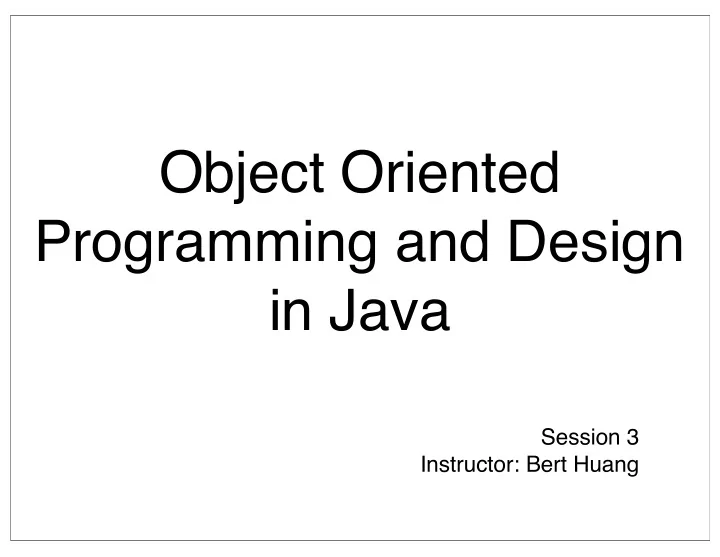

Object Oriented Programming and Design in Java Session 3 Instructor: Bert Huang
Announcements • Next Monday's class canceled for Distinguished Lecture: Feb 1, 11 AM Davis Auditorium. • Course survey due • Homework 1 will be posted soon, "officially" out Feb. 3rd
Review • basic syntax, javadoc, primitive types, references, importing packages, exceptions, input, Arrays, ArrayLists, declaration keywords, code style • CUNIX and Eclipse demo
Today ʼ s Plan • Turning ideas into a program • Use cases • identifying classes • UML diagrams: class diagram, sequence diagram, state diagram • Example: todo list manager
Ideas to Programs Analysis (common sense) Design (object-oriented) (actual programming) Implementation
Phase 1: Analysis • Ideas or description of final product may be inadequate • Specifically describe requirements to be considered a completed program • Decide on exact functionality • Limit ambition, but don ʼ t think too much about design and implementation
Use Cases • Use cases specifically describe the operation of the program • Narrows down exactly what you want your program to do • Useful as test cases • Implementation and design don ʼ t matter
Phase 2: Design • More explicit about object interactions • Define classes of objects • Decide responsibilities of classes • Define attributes and methods of classes
Identifying Classes • Good first step: look for tangible nouns in use cases. Then... • Agents - objects that perform tasks • Events - store information about events • Systems, interfaces - run the program, talk to user or other programs • Foundational classes - String, Date, etc.
Identifying Responsibilities • Good first step: look for verbs, actions in use cases • These actions may directly describe responsibilities, or • may depend on other responsibilities
CRC “Cards” • Class - Responsibility - Collaborators • Brainstorming tool for setting up classes and responsibilities • Collaborators loosely define class relationships; we get more precise later ClassName responsibility 1 Collaborator 1 responsibility 2 Collaborator 2 ... ...
Walkthroughs with CRC • Play out (partial) use cases using CRC • Who does what during the use case? • Do some objects have too much responsibility? • Create helper objects or agents • Are some classes never used?
Universal Modeling Language • Standard formatting rules and syntax for modeling software • More precise than CRC, but still looser than javadoc or actual code skeleton • Start to name methods based on established responsibilities
UML Class Diagrams Class Name • Each class is a rectangle Attributes : Type Methods • Connect classes by their relationship
Class Relationships • Dependency - any time one class needs the other • Aggregation - one class contains elements of the other class • Association - other relationship • Inheritance • Interface Implementation
Sequence Diagrams objectName : other : • Draw objects as they interact Class Class over time doSomething() • UML: underline to indicate instances • Each object has dotted life-line • Activation bars indicate object running • Arrows indicate method calls
State Diagrams hit caps lock Type in Type in all caps lowercase hit caps lock • Useful for visualizing how an object changes over time • Rounded rectangles represent states • Arrows and text describe triggers for state changes
Checkpoint • You should have a tractable design • Manageable class complexity • Clean encapsulation • You can write the code skeleton and javadoc now • Then Phase 3: Implement
Example: Console Todo List Manager • Most programs start with a vague idea: • Hey, <your name>, make me a program that like helps keep track of stuff I have to do. Or whatever. And it should sort by due date.
Use Case 1 • User starts the program • Display saved items numbered and sorted by due date. • User enters “add laundry” at prompt • User is prompted for a due date • User enters date • list updated and displayed with laundry in its correct sorted position
Use Case 2 • User has previously entered todo items, including “laundry” • User starts program • To do list is displayed • User enters “finished laundry” • Laundry is removed from the list, remaining items displayed
Classes and Responsibilities • Nouns: date, item, prompt, list • Verbs: display, enters, add, delete, update, sort • Agents: file manager (saving + loading) • Our classes: TodoItem, TodoPrompt, TodoList, TodoFileManager
CRC TodoItem TodoPrompt Store name, date TodoList Display list TodoList get commands TodoList TodoFileManager Store list of items TodoItem Load list from file TodoList Sort items TodoPrompt Save list to file Add and remove TodoFileManager
CRC Walkthrough TodoItem TodoPrompt Store name, date TodoList Display list TodoList get commands add/delete TodoItem TodoList TodoFileManager Store list of items TodoItem Load list from file TodoList Sort items TodoPrompt Save list to file Add and remove TodoFileManager • User starts the program • Display saved items numbered and sorted by due date. • User enters “add laundry” at prompt • User is prompted for a due date • User enters date • list updated and displayed with laundry in its correct sorted position
Class Diagram
Class Diagram
Sequence Diagram 1
State Diagram
Violet • I used Horstmann ʼ s Violet to draw the UML diagrams on last few slides • http://horstmann.com/violet
Reading • Horstmann Ch. 2 • Look at his VoiceMail example
Recommend
More recommend